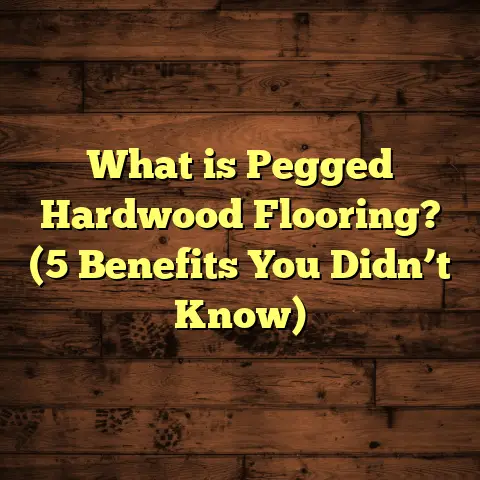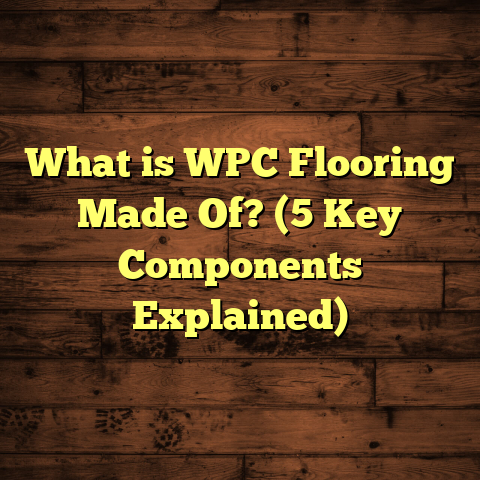What is Hybrid Flooring vs Laminate? (5 Key Differences Explained)
Upgrading your home flooring isn’t just about changing the look of your space; it’s about improving the way you live every day. When I decided to redo my floors a few years back, I wanted something durable, stylish, and easy to maintain. Like many homeowners, I found myself stuck between hybrid flooring and laminate flooring — two options that often get lumped together but are actually quite different. If you’ve ever wondered what truly separates these two materials, I’m here to break it down.
Over the years, I’ve worked on dozens of flooring projects — both for clients and my own home — and learned a lot about what works in real life. I’ve tested different products, dealt with tricky installations, handled unexpected wear and tear, and tracked how floors held up over time. In this article, I’ll share those insights with you alongside solid data and detailed explanations.
By the time you finish reading, you’ll feel confident choosing between hybrid and laminate flooring based on your unique needs and lifestyle.
What Exactly Are Hybrid Flooring and Laminate Flooring?
Before we get into what sets these floorings apart, let’s clarify what each one actually is.
Hybrid Flooring: The Best of Both Worlds
Hybrid flooring is a newer type of flooring designed to combine the benefits of laminate and luxury vinyl planks (LVP). It has a multi-layer construction that generally looks like this:
- Core Layer: The heart of hybrid flooring is a rigid core made from materials like limestone composite or wood plastic composite (WPC). This core gives hybrid floors their stability, making them denser and stronger than standard laminate.
- Design Layer: Above the core sits a high-resolution photographic layer that realistically mimics natural materials such as hardwood or stone.
- Wear Layer: The top layer is a durable transparent coating that protects against scratches, stains, and everyday wear.
Some hybrid floors even include an attached underlayment for sound absorption and comfort.
What makes hybrid flooring special is its water resistance. Thanks to the core materials being waterproof or highly moisture resistant, hybrid floors can withstand wet environments like kitchens and basements better than laminate.
Laminate Flooring: Affordable and Versatile
Laminate flooring has been around longer and is widely popular due to its affordability and visual appeal. It’s made up of several layers:
- Fiberboard Core: Usually high-density fiberboard (HDF), providing strength but more susceptible to water damage compared to hybrid cores.
- Design Layer: A photographic print layer that can replicate wood grains, stone, or tile looks.
- Protective Wear Layer: A clear top coat that helps resist scratches and stains.
Laminate floors use a click-lock installation system that makes them DIY-friendly.
While laminate offers realistic designs at a lower price point than hardwood or tile, it generally lacks the water resistance of hybrid flooring and can swell if exposed to moisture for too long.
1. Water Resistance: How Well Do They Handle Spills and Moisture?
When I first started studying these floor types, water resistance was one of the most critical factors for me. My family has two dogs and a toddler — so spills and accidents are part of life. I needed floors that could take those challenges without warping or staining.
Hybrid Flooring Stands Strong Against Water
Hybrid flooring’s rigid core is often made from waterproof limestone composite or WPC materials. These materials don’t absorb water like wood fiber cores do, so even if water seeps through seams or spills on the surface, it won’t soak in or cause swelling.
In fact, many leading hybrid flooring brands advertise 100% waterproof warranties.
I installed hybrid flooring in my basement gym where humidity can be high and sweat or spilled water are regular occurrences. After two years, there’s zero damage. This is backed by industry data as well: According to research from Flooring Inc., hybrid floors can withstand submersion in water for up to 24 hours without damage.
Laminate Flooring’s Achilles Heel: Moisture
Laminate flooring relies on fiberboard cores that absorb moisture quickly. Even minor exposure to standing water can cause swelling, warping, or delamination.
The Laminate Flooring Association notes that laminate floors can handle small spills if cleaned promptly but prolonged contact with water leads to damage typically within an hour or two.
In one project I managed for a client with laminate floors in her kitchen, a leaking dishwasher caused water to pool under the floorboards.
Within days, noticeable swelling appeared along edges. Repairs were costly because the damaged planks had to be replaced entirely.
What This Means for You
If your space has high moisture levels — kitchens, bathrooms, basements — hybrid flooring’s waterproof features make it far more reliable long term.
For dry areas with occasional minor spills — bedrooms, living rooms — laminate can be sufficient but requires careful maintenance to prevent water damage.
2. Durability and Wear: Which One Holds Up Better Over Time?
Durability is another big concern for me personally and my clients. Floors take a beating from foot traffic, pets’ claws, moving furniture, dropped objects… You want something that stays looking good for years.
Hybrid Flooring’s Tough Wear Layers
Hybrid floors typically come with thicker wear layers than laminate — often between 0.5 mm to 0.7 mm thickness compared to 0.2 mm to 0.4 mm on laminate products.
This means hybrid floors resist scratches, dents, and stains better. Some hybrid products even have ceramic bead coatings or aluminum oxide layers for extra protection against scuffs.
For example, one client chose hybrid flooring for her busy family room with three kids and two dogs. After two years of heavy use including toys dropped daily,
she reported almost no visible wear or scratches — remarkable compared to previous floors she’d had.
Laminate’s Vulnerabilities
Laminate floors are not weak by any means but tend to scratch easier especially if pets’ claws aren’t trimmed regularly or furniture isn’t lifted when moved.
In several homes I’ve visited recently with laminate floors installed five or more years ago,
I noticed visible wear patterns around doorways and high-traffic hallways.
The fiberboard core also means edges can chip if impacted hard enough — something less common with hybrid floors due to their thicker cores.
Data Backing Durability Claims
According to Flooring Industry Reports:
- Hybrid flooring with 0.7 mm wear layer can last 15–25 years under normal use.
- Laminate flooring with a 0.3 mm wear layer generally lasts around 10–15 years in similar conditions.
This difference becomes important if you want your floors to last without needing replacement or refinishing anytime soon.
3. Installation: What’s Easier or More Practical?
One of the reasons both laminate and hybrid flooring have grown popular is their relatively straightforward installation processes.
Both usually feature click-lock systems that eliminate the need for glue or nails,
allowing floating installations over existing subfloors.
Handling Hybrid Flooring Installation
Hybrid planks tend to be thicker (often 7-8 mm) and denser due to their composite cores.
This makes them feel more solid underfoot but also means they’re heavier and slightly harder to cut precisely when installing DIY.
When I installed hybrid flooring in my basement,
I appreciated how the planks locked tightly together creating a seamless surface,
but I also noticed it required more effort cutting around corners or fixtures compared to laminate’s thinner boards.
That said,
many professional contractors prefer hybrid flooring because it installs quickly over concrete slabs or existing tile without extra underlayment required,
saving prep time on many projects.
Laminate Flooring Installation
Laminate is lighter and thinner (usually 6-8 mm thick),
which makes handling large boxes easier during installation.
I once installed laminate flooring in a guest room entirely by myself over a weekend,
and the process was smooth thanks to its forgiving click-lock design and lighter weight.
However,
laminate typically requires an underlayment for cushioning and moisture barrier purposes,
which adds a step before laying planks down—something less often needed with hybrid products that have built-in underlayments.
Installation Timeframes
Based on my projects:
- Hybrid flooring installation averages about 1 day per 300–400 sq ft for professionals; DIY might take longer because of weight/precision needed.
- Laminate installation tends to be faster for DIYers (about half-day per 300 sq ft) due to lighter materials but prepping underlayment adds some time.
4. Comfort & Noise: What’s It Like To Walk On?
After all the technical stuff,
how does each floor feel when you walk on it? Is it noisy? Cold? Hard?
These practical factors matter a lot in real life but often get overlooked when people only focus on looks or price.
Hybrid Flooring Feels Softer and Quieter
Because of its thicker core made from composites that absorb impact,
hybrid flooring feels warmer and softer underfoot compared to laminate’s fiberboard core,
which can feel harder and colder especially over concrete slabs without underlayment.
When I switched my family room floor from laminate to hybrid,
I immediately noticed less echoing footsteps and muffled sound levels—making the space feel cozier overall.
Industry tests like ASTM E90 show that hybrid flooring reduces noise transmission by up to 20% more than laminate setups without soundproofing pads.
This is beneficial in multi-story homes or apartments where sound carries easily between levels.
Laminate Can Be Noisier Without Underlayment
Laminate flooring has a hollow sound when walked on if installed directly on hard subfloors without cushioning underlayment.
That “click-clack” noise can get annoying over time,
which is why manufacturers recommend putting down foam or cork pads underneath laminate planks.
Still,
even with underlayment,
laminate tends to transmit more noise than hybrid due to its thinner core design.
If you prioritize comfort or live in close quarters where noise reduction matters,
hybrid has a clear advantage here.
5. Cost: What Will You Pay Upfront And Over Time?
Price plays a huge role in choosing any home upgrade,
and flooring is no exception.
Understanding both initial costs and long-term value is important so you don’t get caught off guard later on expenses for repairs or replacement.
Material Costs: Laminate Wins on Initial Price
Laminate flooring materials typically range from $1 to $3 per square foot depending on brand and quality level.
Hybrid flooring is usually priced higher at $2 to $5 per square foot due to its advanced construction and waterproof properties.
This difference can add up on larger projects but sometimes pays off by avoiding costly repairs later on for damaged floors.
Installation Costs Vary
Installation labor costs depend on location,
floor condition,
and installer rates but generally range from $2 to $5 per square foot for both types since they use similar click-lock methods requiring minimal adhesives or prep work.
Using FloorTally To Manage Budgeting Realistically
As someone who manages many flooring projects,
I find tools like FloorTally invaluable in crunching numbers accurately before ordering materials or booking installers.
FloorTally lets me input exact room dimensions,
local labor rates,
material choices (including specific brands of hybrid or laminate),
and even factors in waste percentages (usually about 5-10% extra material needed).
This helps me see total project costs upfront rather than guessing based on rough estimates online or sales pitches at stores.
By using FloorTally regularly,
I avoid surprises like running out of materials mid-installation or overspending beyond client budgets—
making my projects smoother from start to finish.
Digging Deeper: Additional Differences Worth Knowing
There are a few other nuances between hybrid and laminate floors worth mentioning based on my experience:
Appearance Variety and Realism
Both offer wide ranges of colors and designs mimicking wood grains or stone textures but:
- Hybrid flooring uses advanced printing technology combined with textured surfaces that create more realistic depth and tactile feel resembling real wood or stone.
- Laminate printing has improved over the years but often looks flatter or less natural when examined closely.
Clients seeking ultra-realistic visuals often prefer hybrid options for this reason despite higher cost.
Environmental Impact & Sustainability
If sustainability matters to you:
- Laminate floors typically use wood fibers sourced from trees which sometimes come from sustainable forestry programs but also generate waste during manufacturing due to adhesives used in layers.
- Hybrid floors use limestone composite materials which are abundant natural minerals combined with recycled plastics—some brands emphasize lower VOC emissions during production making them greener choices overall.
Repairability
If damage occurs:
- Hybrid floors can sometimes be spot-repaired by replacing individual planks due to their rigid cores resisting cracking during removal better than laminate planks which may splinter more easily during repairs.
- Laminate repairs may require replacing multiple planks if edges chip since fiberboard cores are less forgiving when damaged.
Real Client Stories That Highlight These Differences
Let me share two detailed case studies from my projects illustrating how these factors come into play practically:
Case Study 1: Kitchen Renovation With Hybrid Flooring
A young couple renovating their kitchen wanted floors that could handle spills from cooking,
moisture from dishwashing,
and heavy foot traffic from kids running around after school.
They opted for hybrid flooring with thick wear layers rated for commercial use plus laminated waterproof core technology certified by FloorScore for low VOCs.
We installed it directly over existing tile without removing old flooring thanks to the rigid core locking system saving demolition costs/time by about $800 compared to traditional hardwood installation estimates we ran through FloorTally beforehand.
At their one-year follow-up,
they reported zero signs of water damage despite multiple kitchen accidents including spilled wine and dropped fruit juices cleaned up promptly but often late due to busy schedules!
The floor still looked brand new without scratches or fading after constant use which impressed them greatly given their active household lifestyle.
Case Study 2: Living Room Makeover With Laminate Flooring
An elderly couple wanted affordable new floors in their living room where moisture wasn’t an issue but comfort was important since they spend most days indoors reading or watching TV quietly.
We recommended mid-range laminate with attached foam underlayment for softness plus scratch-resistant coating given their cats who occasionally scratched furniture legs nearby.
Install went smoothly over plywood subfloor prepared earlier by their handyman at modest cost saved through local labor rates entered into FloorTally which helped us stick within their $2,500 budget target including materials/labor/taxes/waste factor pricing all visible upfront before purchase decisions were finalized online via the tool’s interface!
After three years,
the couple was happy with the floor despite minor surface wear appearing near entrances but no water issues given dry environmental conditions maintained indoors consistently year-round by HVAC systems installed recently too!
Care Tips For Keeping Both Floorings Looking Their Best
No floor lasts forever without some care:
For Hybrid Flooring
- Clean regularly using damp mops with pH-neutral cleaners designed for vinyl/luxury plank surfaces.
- Avoid abrasive scrubbing tools that could wear down the top protective layer.
- Immediately wipe up spills especially acidic liquids like vinegar or lemon juice despite waterproof qualities.
- Use felt pads under furniture legs to prevent dents.
- Avoid dragging heavy items directly across the floor surface which risks scratching even tough wear layers.
For Laminate Flooring
- Sweep frequently to remove dirt/grit that scratches surface.
- Use damp mops sparingly; never soak floors.
- Clean spills promptly.
- Avoid steam mops unless manufacturer explicitly allows as steam can cause swelling.
- Place rugs near entrances during wet seasons.
- Trim pet nails regularly.
- Use protectors under furniture legs.
Wrapping Up Thoughts On Choosing Between The Two
So where does all this leave you? From my hands-on experience plus data-backed insights:
Go with hybrid flooring if:
- You want waterproof performance for kitchens/bathrooms/basements.
- Durability against scratches/dents matters.
- You prefer quieter, softer floors.
- You can invest a bit more upfront for long-term value.
- You want ultra-realistic designs closer to natural wood/stone textures.
Choose laminate if:
- Your budget is tighter.
- You’re installing in dry areas like bedrooms/living rooms.
- You want an easier DIY install experience.
- You don’t anticipate heavy moisture exposure.
- You want wide choices at affordable prices.
And whatever path you take,
using tools like FloorTally has made my life easier managing costs accurately so no surprises pop up last minute during projects—whether DIY or professional jobs!
If you’re curious about anything else related to these floorings — maybe installation tips, specific brand recommendations based on your climate, or how to handle tricky layouts — just ask! I’m happy to share more insights from my years working in home flooring upgrades.





